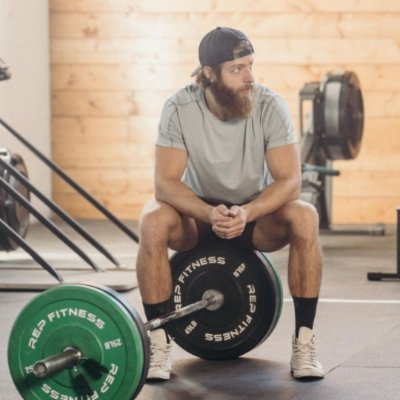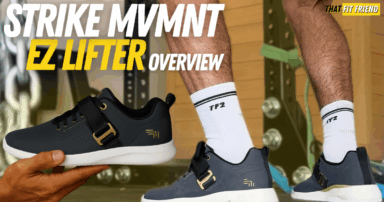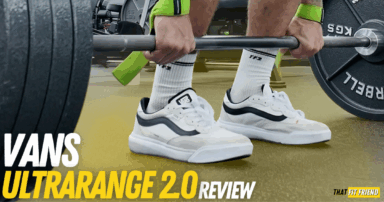There’s no denying that training shoes can get seriously beat up in our gym sessions. Things like rope climbs, burpees, handstand push-ups, plyometrics, heavy squats, and the work, can all lead to shoe breakdown over time.
For running shoes, most experts recommend replacing shoes around 300-500 miles. However, there’s not a clear formula for cross-training shoes as they’re generally used in a range of activities. This makes it harder to create a clear answer for replacing them.
After being asked this question countless times in shoe reviews on my YouTube channel, I thought it was time to create a formula for when lifters and athletes should replace cross-training shoes. This formula is based on two key criteria.
- My observations from the countless cross-training shoes I’ve reviewed.
- My coaching background for what lifters/athletes will need from their shoes during various activities.
By tying my review and coaching experience together, I’m able to assess replacing cross-training shoes from both product and performance points of view.
My Formula for Replacing Cross-Training Shoes
My cross-training shoe replacement formula looks at three key construction characteristics that can heavily influence performance and if you should replace your cross-trainers. When in doubt, always remember, OMU.
- O = Outsole
- M = Midsole
- U = Upper
These are the three key construction players that can negatively impact performance if they’re breaking down on your cross-trainers. I’ve ordered them in a hierarchy system from the most concerning to the slightly less concerning.
I’ll then use the guide below to answer questions about the cross-training shoes in question to decide if I should replace them or not.
Outsole Breakdown
The “O” stands for the outsole construction. The outsole is the bottom of the shoe and plays a major role in stability and traction which are incredibly important for lifting, plyometrics, agility, running, and this list goes on.
If you notice that your shoe’s outsole is lipping on the toe, peeling off at any point, and losing traction on any edge, then it’s time to replace your shoes. In our OMU formula, this is a non-negotiable construction characteristic that will take precedence over other characteristics.
The Bottom Line: Outsole breakdown can impact traction and stability and warrants the replacement of your shoes.
Midsole Breakdown
The “M” means midsole construction. The midsole is the material that separates the outsole and inside of the shoe (insole). Regarding cross-training shoes, midsole construction plays a key plays in a shoe’s responsiveness and stability.
If you notice your shoe’s midsole “shrinking” or biasing one side of the shoe (left is more compressed than right), then it’s time to replace your shoes. Similar to our outsole section, this type of breakdown is non-negotiable and should warrant the replacement of your shoes.
From a coaching point of view, if your shoe’s ability to create stability is depleted or biasing one side, then we could run into creating compensatory movement patterns to make up for the lack of stability. This is why I place outsole and midsole breakdown as non-negotiables because they can lead to a greater negative impact on performance — and movement in general.
The Bottom Line: Beat-up midsoles can impact stability and overall movement mechanics, at times, and like outsole breakdown, require shoe replacement.
Upper Breakdown
The “U” means upper construction. The upper of a cross-training shoe is important because it provides the shoe with its overall security and breathable nature. Plus, it protects the foot from additional friction and potential abrasion from external surfaces.
If you notice your shoe’s upper is breaking down, then you should think about replacing your cross-training shoes in the very near future. It’s not a non-negotiable because there are various forms of upper construction breakdown and not every type warrants immediate replacement.
For example, if you have some wear on the lateral side of the shoe but it doesn’t impact performance or comfort, then you can likely rock your shoes for a bit longer. Conversely, if you have a hole above the toe and you experience toe pain during things like burpees or even sock breakdown, then you should replace the shoes sooner rather than later.
The Bottom Line: Upper breakdown does not always mean immediate replacement, however, if you’re breaking down socks/having pain, then you should replace them sooner rather than later.
Why It’s Important to Replace Cross-Training Shoes
Now that I review shoes for training full-time, I’m frequently rotating models. However, before I found this love, I was the type of guy who would wear shoes until they literally couldn’t be called shoes. I would tape shoes to prolong their life if I loved them.
That being said, I get the knee-jerk pushback some to have when it comes to replacing their shoes. “If it’s not broken, why fix it?” In this context, ignorance is not true bliss.
Knowing what I know now, it’s clear that I should have replaced countless pairs of shoes when I was younger. The more I learn about movement mechanics, gait, and how shoes can support various realms of performance, it becomes increasingly more evident how important replacing your shoes promptly can be.
We briefly discussed this topic above, but when shoes hit certain levels of breakdown, we can run into various problems with our training. Five of the bigger issues we can run into when cross-training include:
- Poor Stability — This can impact performance when working with heavy loads.
- Biased Movement — If one side of the shoe is worn down, then we may bias how we’re moving.
- Less Impact Protection — Lacking or beat up materials can limit joint protection from impact-focused exercise.
- Decreased Foot Protection — Torn up uppers can limit how much our foot is protected from friction.
- Inconsistent Feeling — If one shoe is more beat up than the other, then your overall “ride” will be different.
This list could go on, but these are the primary five that I’ll list when athletes ask. When cross-training we have a lot of performance buckets to fill, so if one area is lacking, then others can start to lack, too.
How to Make Cross-Training Shoes Last Longer
I have a couple of tips to help you make your cross-training shoes last longer. Please note, that the below can always vary based on models, but these are the best, most consistent tips I’ve found and recommend.
1. Wear Them Only for Training
Easier said than done at times, but if you truly want your shoes to last, then limit their wear to only cross-training sessions. This means either only wearing them to and back from the gym or even bringing them in a bag and putting them on before your training session.
At times, we can forget how much day-to-day wear and weather elements can add up to impact shoe durability. If you only wear your shoes to the gym and back, you’ll limit outsole and upper breakdown by a fairly large margin compared to wearing them every day.
2. Rotate Two Pairs
This option is not always feasible, especially for those trying to limit spending, but rotating shoes can be incredibly useful for prolonging a model’s life. For this method, you’ll rotate your trainers every few sessions to prevent them from accumulating a ton of breakdown.
I would highly suggest rotating the same pair of cross-trainers to avoid discrepancies in how models perform. Do note, that this tip is best for those who LOVE a model and have the means to buy two pairs. It’s not a must, but it can help!
3. Give TLC When Needed
You don’t have to pamper your cross-training shoes after every single session, however, giving them some TLC every once in a while can be useful. For example, if your shoes are exceptionally dirty, then take a few minutes to wipe them down with some warm water, then store them with some newspaper in a warm location for a few hours.
This point is also important for anyone who trains outside regularly. Dirt and water can lead to a quicker breakdown, so be mindful of the elements you’re training in and pamper your shoes accordingly.
Takeaway Lessons Learned
Old broken-down cross-training shoes should be replaced when they have the potential to impact performance. When we’re training hard and heavy, the last thing we want to worry about is a pair of shoes causing our performance dip.
By using OMU to assess your shoes, you can more accurately replace your shoes when they need it most.








Add a Comment